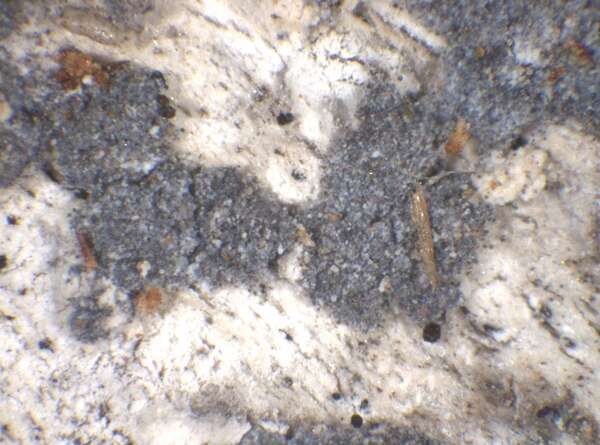Lecanographa amylacea (Pers.) Egea & Torrente (trebouxioid)
Bibl. Lichenol., 54: 122, 1994. Basionym: Lichen amylaceus Ehrh. ex Pers. - Plant. Crypt. Exsicc.: 303, 1793.
Synonyms: Buellia violaceofusca G. Thor & Muhr
Distribution:
Description: This lichen appears in two very different morphotypes, depending on the photobiont: 1) Morphotype with Trentepohlia (corresponding to the type): Thallus crustose, episubstratic, continuous to rimose, thick, chalky white to grey-white, farinose, usually with numerous, pale brown, c. 0.2 mm wide granular flecks, sometimes delimited by a discontinuous, dark prothalline line. Apothecia not always present, round to irregular in outline but never lirelliform, 0.2-0.6 mm across, more or less immersed in the thallus, with a concave to slightly convex, black but densely white-pruinose disc and a thin, usually epruinose, black, persistent proper margin. Proper exciple black, extending below the hymenium; epithecium brown; hymenium colourless, 65-85 µm high, I+ blue, then reddish; paraphysoids sparingly branched and anastomosing, 1-1.5 µm thick, with poorly swollen, brown-tipped apices; subhymenium pale brown, 30-40 µm high; hypothecium dark brown to black. Asci 8-spored, subcylindrical, fissitunicate, the apex with a narrow, K/I+ pale blue dome penetrated by a small ocular chamber surrounded by a small but usually evident, K/I+ dark blue, ring-like zone. Ascospores 3(-4)-septate, hyaline, fusiform, straight or slightly curved, (14-)17-25(-28) x (2-)3-3.5 µm, with a thin gelatinous perispore. Pycnidia rare, immersed, globose, black. Conidia hyaline, bacilliform, 5-7 x 1-1.2 µm. Photobiont trentepohlioid. Spot tests: thallus K- or K+ yellow-orange, C. KC-, P-, UV-; medulla UV+ citrine-glaucous. Chemistry: an unknown UV+ substance in the medulla. 2) Morphotype with Trebouxia (corresponding to Buellia violaceofusca G. Thor & Muhr): Thallus crustose, endosubstratic or episubstratic and then granular, up to 0.15 mm thick, pale grey to almost white, with scattered, maculiform, 0.15-0.6 mm wide, often confluent soralia which are dark dirty brown with a violet tinge, (greenish when abraded), the soredia 15-20(-23) µm wide, with brown, 1.8-2.5 µm thick outer hyphae, the inner colourless hyphae 1.3-1.7(-2) µm thick. Apothecia and pycnidia not known. Photobiont chlorococcoid. Spot tests: all negative, except the pigmented outer hyphae of the soredia, which react K+ greenish grey, N+ red-brown. Chemistry: without lichen substances. Note: a mild-temperate, mainly western lichen found on isolated, old deciduous trees with acid bark, especially oaks, on faces seldom wetted by rain. According to Ertz & al. (2018), the sorediate Buellia violaceofusca G. Thor & Muhr seems to be a trebouxioid photomorph of this species, the fungus, depending on the photobiont type, changing the morphology and the reproduction strategy. The trebouxioid morph, known from Scandinavia and Western-Central Europe, and the Eastern Alps (Austria), grows on the fissured bark of more or less isolated old deciduous tress (especially Quercus and Fraxinus), and should be looked for in Italy.
Growth form: Crustose
Substrata: bark
Photobiont: green algae other than Trentepohlia
Reproductive strategy: mainly asexual, by soredia, or soredia-like structures (e.g. blastidia)
Most common in areas with a humid-warm climate (e.g. most of Tyrrenian Italy)
In underhangs rarely wetted by rain

Predictive model
Growth form: Crustose
Substrata: bark
Photobiont: green algae other than Trentepohlia
Reproductive strategy: mainly asexual, by soredia, or soredia-like structures (e.g. blastidia)
Most common in areas with a humid-warm climate (e.g. most of Tyrrenian Italy)
In underhangs rarely wetted by rain

Predictive model
 Index Fungorum
Index Fungorum
 GBIF
GBIF




